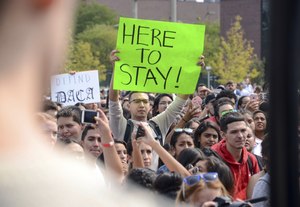
When enrollment numbers decrease, districts face a reduction in funding such as Title I, state equalization and Maintenance and Operation (M&O) monies.
“Once social change begins, it cannot be reversed. You cannot un-educate the person who has learned to read. You cannot humiliate the person who feels pride. You cannot oppress the people who are not afraid anymore.” The words of American labor leader and civil rights activist, Cesar Chavez, still ring true today. This quote was part of a speech at the Commonwealth Club in San Francisco on November 9, 1984. You cannot take dreams away from those who dream of a better life.
Deferred Action for Childhood Arrivals (DACA) is a program initiated in 2012 by former President Barack Obama to grant amnesty to some undocumented immigrants (known as "Dreamers"), including many children who entered the United States illegally. Dreamers have two years to stay in this country, and then must apply to stay longer. According to the U.S. Customs and Border Patrol, as of September 4, 2017, there were 689,800 active DACA recipients. Approximately 40,000 DACA recipients have gained lawful permanent resident (LPR) status; 70,000 didn’t renew at the end of their 2-year validity time span or were denied approval. Consider the following DACA statistics from September 2017: 79.4 percent from Mexico, 3.7 percent from El Salvador, 2.6 percent from Guatemala, 2.3 percent from Honduras, 1.1 percent from Peru and 1.1 percent from South Korea. Other countries with less than 1 percent represented include China, India, Argentina, Pakistan, Nigeria, Israel and the Philippines. These immigrants were given a six-month reprieve in 2017, which ends in March 2018. A federal judge in San Francisco temporarily blocked President Donald Trump’s administration efforts to halt DACA, citing irreparable harm to immigrant children. DACA, the building of a new border wall with Mexcio, and immigration policies continue to plague the country with political battles threatening government shutdown and other social stressors.
In Arizona, there are 30,000 to 36,000 Dreamers. Regardless of your political views, the possible end of DACA will have an enormous negative impact on countless families, the economy and public schools. If student and family Dreamers are deported, that means less money for schools based on drops in enrollment. An “unaccompanied alien child” is defined legally as one who is under 18 years of age, lacks lawful immigration status and has no parent or guardian residing in the United States. Children arriving in the country with parents are considered accompanied. In Arizona, between October and December 2017, there was a 47 percent drop in unaccompanied children and a 55 percent drop in family units caught at the border compared to the same period in 2016.
Considering 2015 U.S. Census Bureau and U.S. Department of Education data, more than 4.7 million students born in other countries were enrolled in U.S. schools, representing approximately 6 percent of the school population. Twenty million additional students were children of parents born in other countries. When enrollment numbers decrease, districts face a reduction in funding such as Title I, state equalization and Maintenance and Operation (M&O) monies. The 2018-2019 school year represents a possible drop in funding, which would force districts to look elsewhere for money to fill the void, increase classroom sizes or lay off valuable staff.
As a former teacher, I worked with several Dreamers who were brought to the United States by parents who desired a better life for their children. The journey was never easy, leading to traumatic memories these students deal with daily. Many face poverty and other related family stressors, along with worrying more than ever about being deported. These stressors affect a student’s ability to learn in the classroom.
To make a great dream come true, the first requirement is a great capacity to dream; the second is persistence.” Thank you, Mr. Chavez. Let’s all continue to dream and practice persistence in realizing those dreams for education.
Copyright © 2024 EducationGrantsHelp.com. All rights reserved.
